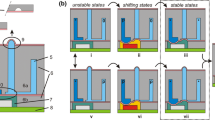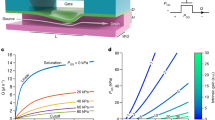Abstract
New strategy in design of single-use burst microfluidic valves is based on the physico-chemical properties of the valve actuator. The different dissolution rates of salt-based actuators allowed the control of the timing of the opening of the autonomous timed microfluidic valves in the range of seconds to a few minutes by using, as dissolvable actuators, NaCl crystals and for range between several minutes and hours by using actuators made of CuSO4 crystals. Autonomous timed microfluidic valves are successfully used to determine the concentration distribution of a contaminant tracer in groundwater at scheduled times.





Similar content being viewed by others
References
Baedecker MJ, Cozzarelli IM (1992) The determination and fate of unstable constituents in contaminated groundwater. In: Lesage S, Jackson RE (eds) Groundwater contamination and analysis at hazardous waste sites. Marcel Dekker, New York, pp 425–461. ISBN: 9781420032246
Brett M-E, Zhao S, Stoia JL, Eddington DT (2011) Controlling flow in microfluidic channels with a manually actuated pin valve. Biomed Microdevices 13:633–639
Crestani CE, Bernardo A, Costa CBB, Giulietti M (2013) Fructose solubility in mixed (ethanol + water) solvent: experimental data and comparison among different thermodynamic models. J Chem Eng Data 58(11):3039–3045
Dong L, Jiang H (2007) Autonomous microfluidics with stimuli-responsive hydrogels. Soft Matter 3:1223–1230
Dos Torrão JND, Santos MPS, Ferreira JAF (2015) Instrumented knee joint implants: innovations and promising concepts. Expert Rev Med Devices 12:571–584
Fishman MJ, Skougstad MW (1963) Indirect spectrophotometric determination of traces of bromide in water. Anal Chem 35(2):146–149
Fu E, Lutz B, Kauffman P, Yager P (2010) Controlled reagent transport in disposable 2D paper networks. Lab Chip 10(7):918–920
Gorkin Iii R, Nwankire CE, Gaughran J, Zhang X, Donohoe GG, Rook M, O’Kennedy R, Ducree J (2012) Centrifugo-pneumatic valving utilizing dissolvable films. Lab Chip 12(16):2894–2902
Gravesen P, Branebjerg JJ, Ole S (1993) Microfluidics—a review. J Micromech Microeng 3:168–182
Jahanshahi-Anbuhi S, Henry A, Leung V, Sicard C, Pennings K, Pelton R, Brennan JD, Filipe CDM (2014) Paper-based microfluidics with an erodible polymeric bridge giving controlled release and timed flow shutoff. Lab Chip 14(1):229–236
Jo B-H, Lerberghe Van LM, Motsegood KM, Beebe DJ (2000) Three-dimensional micro-channel fabrication in polydimethylsiloxane (PDMS) elastomer. J Microelectromech Syst 9:76–81
Knopman DS, Voss CI, Garabedian SP (1991) Sampling design for groundwater solute transport: tests of methods and analysis of Cape Cod tracer test data. Water Resour Res 27(5):925–949
Lin G, Jing L (2004) Ice valve for a mini/micro flow channel. J Micromech Microeng 14(2):242
Lutz B, Liang T, Fu E, Ramachandran S, Kauffmana P, Yagera P (2013) Dissolvable fluidic time delays for programming multi-step assays in instrument-free paper diagnostics. Lab Chip 13:2840–28476
Macheleidt W, Herlitzius J, Nestler W, Grischek T (2004) A temporary sampling technique for investigating groundwater quality near the ground surface. Environ Geol 46:257–262
Malloggi F (2016) Microfluidics: from basic principles to applications. Lect Notes Phys 917:515–546
Nasabi M, Tehranirokh M, Tovar-Lopez FJ, Kouzani A, Khoshmanesh K, Mitchell A (2014) Design characterization and application of a novel mono-layer pin-microvalve for microfluidic devices. RSC Adv 4(46):24394–24398
Nicklasson M, Brodin A (1984) The relationship between intrinsic dissolution rates and solubilities in the water—ethanol binary solvent system. Int J Pharm 18(1):149–156
Nielsen David M (2005) Practical handbook of environmental site characterization and ground-water monitoring, 2nd edn. CRC Press. ISBN: 9781420032246
Noh H, Phillips ST (2010) Fluidic timers for time-dependent point-of-care assays on paper. Anal Chem 82(19):8071–8078
Noyes AA, Whitney WR (1897) The rate of solution of solid substances in their own solutions. J Am Chem Soc 19(12):930–934
Santini JT, Cima MJ, Langer R (1999) A controlled-release microchip. Nature 397:335–338
Schincariol RA, Schwartz FW (1990) An experimental investigation of variable density flow and mixing in homogeneous and heterogeneous media. Water Resour Res 26:2317–2329
Sia SK, Whitesides GM (2003) Microfluidic devices fabricated in poly(dimethylsiloxane) for biological studies. Electrophoresis 24:3563–3576
Whitesides GM (2013) Viewpoint on “Dissolvable fluidic time delays for programming multi-step assays in instrument-free paper diagnostics”. Lab Chip 13:4004–4005
Yang B, Lin Q (2007) A latchable microvalve using phase change of paraffin wax. Sens Actuators, A 134(1):194–200
Acknowledgments
The author acknowledges the financial support from FIR 2014—Marletta (University of Catania) and the geologist A. Serges for the collaboration in the case study.
Author information
Authors and Affiliations
Corresponding author
Rights and permissions
About this article
Cite this article
Tuccitto, N. A physico-chemical timer: autonomous time-delayed microfluidic valves for environmental applications. Microfluid Nanofluid 20, 129 (2016). https://doi.org/10.1007/s10404-016-1795-1
Received:
Accepted:
Published:
DOI: https://doi.org/10.1007/s10404-016-1795-1




